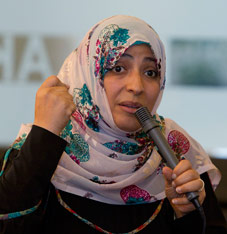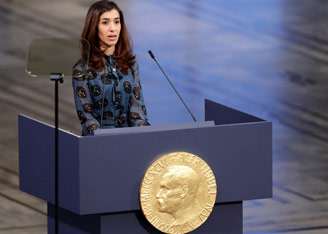The Cold War
Science and innovation

NATO’s Nobel network
NATO has forged connections with a large network of Nobel laureates since the Alliance was founded in 1949. Some of them have had their research directly supported by NATO grants. Some have participated in NATO-funded workshops and conferences. And some contributed to founding NATO’s Science Programme in 1958 and developing the Alliance’s structures for supporting scientific research.
Take the quiz to see which NATO-affiliated Nobel laureate you are most like, and check out the profiles below to learn more about the extraordinary researchers who have been part of NATO’s Nobel network!
Which NATO-affiliated Nobel laureate are you?
Take the quiz to find out!
Dozens of scientists involved in NATO science projects have won Nobel Prizes. From French liquid crystals physicist Pierre-Gilles de Gennes to Egyptian-American "father of femtochemistry" Ahmed Zewail, these scientists have made major contributions in many research areas.
Answer the 10 questions below to learn which NATO-affiliated Nobel laureate you are most like.

Isidor Isaac Rabi
United States
1944 Nobel Prize in Physics
Isidor Isaac Rabi received the Nobel Physics Prize for developing a method to record the magnetic properties of atomic nuclei. This method was instrumental in the creation of many technologies, including atomic clocks, lasers and magnetic resonance imaging (MRI). He was the first United States representative on the NATO Science Committee and in that capacity he helped reorient NATO's science programme from prioritising defence technologies (in the Cold War context of the Soviet Union's launch of the first Sputnik satellite) towards addressing environmental problems. He was close friends with J. Robert Oppenheimer and consulted on the development of the atomic bomb, and also played a key role in creating radar. (Photo credit: thefamouspeople.com)

Lester B. Pearson
Canada
1957 Nobel Peace Prize
Lester B. Pearson received the Nobel Peace Prize for his work establishing the first United Nations peacekeeping force, which helped resolve the Suez Crisis and prevented the outbreak of a war. He also helped create the North Atlantic Treaty in 1949. He is unusual on this list of laureates in that he was not a researcher or scientist – but he did contribute to the establishment of the NATO Science Programme in 1958, laying the groundwork for thousands of Allied and partner countries' scientists to benefit from NATO's support. Finally, he served as Prime Minister of Canada and introduced the country's distinctive maple leaf flag. (Photo credit: NATO Archives)

Louis Néel
France
1970 Nobel Prize in Physics
Louis Néel received the Nobel Prize in Physics in 1970 for his discovery of the concepts of antiferromagnetism and ferrimagnetism, which had practical applications in the improvement of computer memory units, the creation of synthetic materials for microwave electronics (including telephones, radio, television, motors, loudspeakers and microphones) and the study of the Earth's magnetic field. He served as the French representative on the NATO Science Committee for more than 20 years. The 1970 Physics Prize was also awarded to Hannes Alfvén. (Photo credit: Wikimedia Commons)

Nicolaas Bloembergen
The Netherlands/United States
1981 Nobel Prize in Physics
Nicolaas Bloembergen received the Nobel Prize in Physics in 1981 for his contributions to the field of laser spectroscopy. He was known as the father of nonlinear optics, a theory he created to explain the interaction of high-energy electromagnetic radiation (like lasers) with matter. He participated in the first NATO Science Forum, "Highlights of the Eighties and Future Prospects in Condensed Matter Physics", held in Biarritz, France in September 1990. During the occupation of the Netherlands in the Second World War, he ate tulip bulbs to survive and read quantum physics books by the light of an oil storm lamp while hiding from Nazis. The 1981 Physics Prize was also awarded to Arthur L. Schawlow and Kai M. Siegbahn. (Photo credit: Dutch National Archives)

Wolfgang Ketterle
Germany
2001 Nobel Prize in Physics
Wolfgang Ketterle received the Nobel Prize in Physics in 2001 for creating a new state of matter, Bose-Einstein condensate, using sodium atoms at extremely low temperatures. This state of matter had been predicted more than 70 years earlier by Satyendra Nath Bose and Albert Einstein, and its confirmation provided new insights into the laws of physics. Ketterle received a NATO Science Fellowship while at the University of Hannover, Germany, funding his study at the Massachusetts Institute of Technology (MIT) from 1990 to 1991. His earliest memories of exploring the "technical world" are of building creative inventions with Lego blocks. In this photo, Ketterle shows his sons the Bose-Einstein sodium condensate machine he worked on at MIT. The 2001 Physics Prize was also awarded to Eric Cornell and Carl Wieman. (Photo © Reuters/Jim Bourg)
 Peter Mansfield
Peter Mansfield
United Kingdom
2003 Nobel Prize in Physiology or Medicine
Peter Mansfield received the Nobel Prize in Physiology or Medicine in 2003 for his contributions to magnetic resonance imaging (MRI), allowing doctors to look inside the human body without invasive surgery. Mansfield received NATO research grants in 1977 and 1979 to support his MRI research. Mansfield volunteered as the first test subject of the prototype MRI machine in 1978, despite concerns from others that it could cause a heart attack. He emerged from the machine "dripping like a wet rag" with sweat but otherwise unharmed. He was knighted by Her Majesty Queen Elizabeth II in 1993, becoming Sir Peter Mansfield. The 2003 Medicine Prize was also awarded to Paul C. Lauterbur. (Photo © Reuters/Reuters Photographer)

Aziz Sancar
Türkiye
2015 Nobel Prize in Chemistry
Aziz Sancar received the Nobel Prize in Chemistry in 2015 for his work on DNA repair, which has led to advancements in the treatment of skin cancer. He received a NATO fellowship in 1971-73, and two NATO Collaborative Research Grants in 1986 and 1990. As a young man, he was asked to play football professionally as the goalkeeper on Türkiye's national junior team – but he decided to dedicate his life to science instead. The 2015 Chemistry Prize was also awarded to Tomas Lindahl and Paul Modrich. (Photo © Reuters/Anders Wiklund)
Nobel Peace Prize laureates
The majority of NATO-affiliated Nobel laureates have been associated with the Alliance's science programme, but in addition to Lester B. Pearson above, NATO has also had connections with Nobel Peace Prize winners working in important humanitarian fields.

Jody Williams received the Nobel Peace Prize in 1997 for her work founding and organising the International Campaign to Ban Landmines (ICBL), which led to the Ottawa Convention against anti-personnel mines, signed by 133 countries. Williams participated in a guest speaker programme at NATO, sharing her expertise with the Alliance's Euro-Atlantic Partnership Council Ad Hoc Working Group on Small Arms and Light Weapons and Mine Action. She also launched the 2004 Landmine Monitor Report at NATO Headquarters. While completing her master's degree in international relations, she did aid work in post-conflict El Salvador – helping provide artificial limbs for children who had lost arms and legs, and sparking her lifelong interest in anti-landmine advocacy. In this photo, Williams waves to a procession celebrating the anti-landmine treaty from the balcony of Oslo's Grand Hotel following her Nobel reception. The 1997 Peace Prize was also awarded to the International Campaign to Ban Landmines as an organisation. (Photo © Reuters/STR News)

Tawakkol Karman received the Nobel Peace Prize in 2011 for her work as a journalist and activist, including her fight for democracy and human rights in her home country of Yemen and across the Middle East and North Africa during and after the Arab Spring. She co-founded the group Women Journalists Without Chains. Karman participated in a NATO conference on the Alliance's implementation of United Nations Security Council Resolution 1325 on Women, Peace and Security in 2012, and was a panellist in a session at the NATO 2030 Youth Summit in 2020. One of the youngest-ever recipients of a Nobel Peace Prize, she was only 32 when she was awarded the distinction. The 2011 Peace Prize was also awarded to Ellen Johnson Sirleaf and Leymah Gbowee. (Photo credit: NATO)

Nadia Murad received the Nobel Peace Prize in 2018 for her advocacy work for survivors of genocide and sexual violence, particularly the Yazidi minority in northern Iraq. She became an advocate in 2014, after ISIS attacked her village, murdering hundreds of Yazidi men and subjecting women to beatings and rape. After several months, Murad was able to escape, eventually making her way to Germany and founding Nadia's Initiative to support other survivors and advocate to world governments. In 2020, Murad shared her expertise in a NATO-hosted digital dialogue on the International Day for the Elimination of Conflict-Related Sexual Violence (CRSV), and in a workshop on CRSV at Allied Joint Force Command Naples. In this photo, Murad delivers her Nobel Lecture in the Oslo City Hall. The 2018 Peace Prize was also awarded to Denis Mukwege. (Photo © Reuters/Berit Roald)
These are only a handful of the dozens of Nobel-prize winning scientists, activists and leaders who have been connected with NATO. Check out the full list to learn more!
